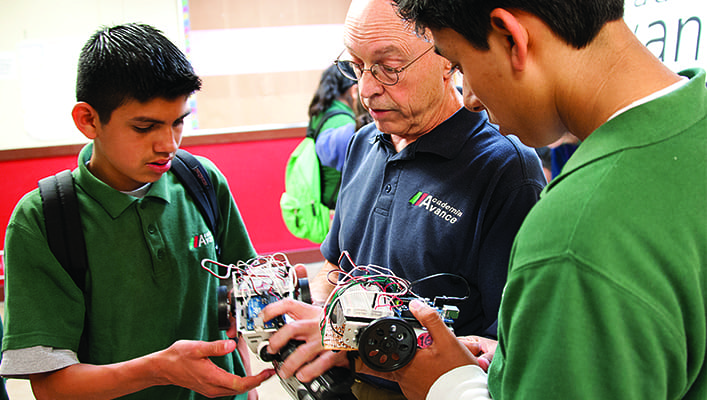CHARTER EDtalks: Board Governance- Episode 1, Featuring Darlene Chambers
On this CHARTER EDtalk, Stuart Ellis, Charter School Capital President, CEO, and Co-Founder of Charter School Capital sat down with Darlene Chambers Sr. Vice President for Programs and Services, National Charter Schools Institute to get her insights and perspective on board governance. Below are the video and transcript from this episode.
Janet Johnson (JJ):
Good morning and welcome to CHARTER EDtalk. I’m here with Darlene Chambers, senior vice president of the National Charter Schools Institute and Stewart Ellis, CEO of charter school capital. And we are here to talk about board governance. I’m going to let Stewart lead off with a question for Darlene, who is our expert on board governance.
The Three-Legged Stool Analogy
Stuart Ellis (SE) : Darlene, charter schools have often been referred to as this three legged stool. I’m not really sure why, but I’m hoping that you’ll share it with us. Why is it important that amongst the three legs, no one leg is particularly more important or longer or shorter than the others?
Darlene Chambers:
I first want to set the stage for three legged stool … I’m a farm kid from southern Indiana, originally. And, yes I had to get up at 4:00 AM and milk the cows. And if you’ve been on a farm, there’s a three legged stool and many farmers think, isn’t it unstable — just three legs? And what happens when you tilt onto one and what happens when a leg gets loose? And how do you milk the cows with a three legged stool?
I think the charter school world – to those who don’t work in it, that have not studied it, and that don’t understand it, don’t know who all the stakeholders are, and who all these players are – our framework – for most of us – comes from that traditional district school where we had a district office, we had a cascading of authority between the district office and the individual school (used to that principal at the school), but other than the district office and the school, that was the operation. It was pretty clear. And then along comes this entrepreneurial space. Let’s create something different in education and let’s create a mixture of business, operations, and a variety of stakeholders and take it away from the framework of just the district office and school.
The Three Legs: Authorizers, Governing Board, and Resources
Darlene Chambers (DC): The players in the charter market can be confusing to most because you have the state with the contract – which is the department of Education in most states – and an entity called an authorizer, which is quasi-governmental in the sense that it has to oversee the contract. It has to decide who gets to open, who gets to close and who’s going to be compliant or not. Then you have the governing board.
So I’ve already named one leg of the stool—the authorizer. You’ve got the governing board and it’s the most forgotten about leg of the stool. I’ll go back to that—and that should be it. Your stool should just have two legs, right? Well, of course that’s just not going to work.
Nobody’s going to be able to sit on a two legged stool. You need to have the resources. The resources can be an educational service provider (ESP). Some people call them management companies—and again, that’s one type of educational service provider, so I tend to go to the ESP piece, but it can be the yellow bus company, it could be the food service, it can be the operators of the school, etc. So the authorizer, the board, and the educational service provider – or the resources – are the three legs of the charter school stool.
I want to go back to my farm analogy … so I’m sitting on a stool and milking cows. You’ve got to have good balance, or you’re going to keel right over and you’re going to make a mess and so you check that stool all the time to make sure there’s no one leg loose because it’s very important to have stability.
The Authorizer:
The authorizer can be hot and cold. It can be overly monitoring. It can be under monitoring where literally the authorizer can open a school and say, ‘I’ll see you in five years’, or it can be an authorizer that’s so involved in the school, that the school can’t breathe. Because for that three legs, our promise has been autonomy for accountability. A fine line.
Board Governance:
The second leg of the stool, the board governance. Remember how I said it was the most forgotten piece? I can’t tell you how much I’ve traveled the country this last decade, trying to help people understand charter schools and how to have high performing schools. I ask the board a simple question. Who is the contract with? (Who’s responsible for that school? Who owns that charter?) A lot of people can’t answer. They don’t understand the board’s role. We sometimes forget as board members, that our responsibilities and our accountability tether to the authorizer.
Resources:
A lot of boards just go, OK, I’m going to hire this provider [resource] and string it together to be able to operate my school and then we’ll just sign the contract and I don’t have to worry about it. Not such a good idea. Also, there are authorizers that if you ask them a question, they may or may not know how many third party contracts that board has signed. Are you seeing how the school gets a little wobbly and why we have this picture of a three legged stool to simply help people outside the framework – and in it – the importance of the three players?
The Brutal Facts
SE: As you look at it and are thinking about boards as one of the key legs, how do you see the difference between boards that are driving the school¬ – the operators – to really flourish as opposed to just make it?
DC: There are two words that sometimes disturb me. I don’t know what to do with them because I’m not sure I want them, but I do want them. The board that helps a school flourish is one who confronts brutal facts — and that’s those two words, brutal facts. You better know the brutal facts and you have to put it in a way that has a relationship behind it. Mutual trust, open communication, and brutal facts. It’s also important to evaluate. You must evaluate yourself and you have to evaluate that third party contract in order for the school to flourish. You have to not forget the roles ¬— because it’s so easy as a busy volunteer. Because charter school board members, they’re volunteers, they’re not elected. Maybe in some states they are, but very few, and that these busy volunteers hire a contractor and they go, ‘phew, we don’t have to worry now’. Well, you’re a parent. I’m a parent. What happens when we stop paying attention to the kids? Uh oh, right? You have to be observant, you have to evaluate, you have to have a good dialogue and communication, a good relationship, and you’ve got to confront the brutal facts, good data (not just saying ‘I did it’, but proving that you have metrics) that shows that you’re on target for the goals in the contract.
SE:
As a board member, with all that data information that drives somebody’s logic can you also lead an organization with your heart?
Darlene Chambers:
What a perfect question for the day and time we live in right now, Stuart. It seems like we only want to hear facts. We want a lot of information and the information is almost like bombardment. If you’re selling data now as a as an entity and you’re selling data to traditional districts, data to superintendents, data to teachers, data, data, data, data, which is all about your head, you think there’s this data and this flurry of activity of talking and using your head is enough. It’s good. But if you ever separate from your heart, you’re going to forget why you even volunteer. You’re going to forget why charter schools even exist, which has a lot to do with the heart. The heart has got to do with the people side of the equation and I think it’s a fine balance between the two. If it’s just hard cold data and no heart, I would say walk away from it. I think, for the community, the parents, the kids, other fellow board members, it’s a blend of using your expertise, listening to others, and evaluating the hard cold facts (which is called reality) with your intuition, with your innate love of education or children in general that will help pick the right facts, will use the right data. Now, let me also say that if you’re a good time person, you like to hug. It’s all about a smile. You want to be everybody’s friend. You want everybody to love you and you disregard the facts that ain’t gonna work either. So it is a fine balance between the head and the heart. And if I can’t sense that there’s a heart behind someone’s conversation with me, pretty much I’ll just walk away and won’t return. I’ve got to have some heart and I’ve got to feel it and I appreciate a person that has both.
JJ: And so with discussions of brutal facts and big hearts we’d like to thank Stuart and Darlene so much for being a part of this Charter EDtalk talk with us.
DC: I’d just like to close with this. If anybody’s interested in volunteering, but they don’t want to run for an office – they don’t want to go through that – but they believe in kids. They believe in families, and they want to engage in the community. Look around you. There might be a charter school out there that could use your expertise. Whether it’s Charter School Capital, or whether it’s the National Charter School Institute, we would be glad to connect you to a charter school where you could use your head and your heart. We need you.
JJ: Thanks.
SE: Thank you.



